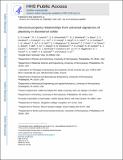Structure-property relationships from universal signatures of plasticity in disordered solids
Author(s)
Cubuk, E. D.; Ivancic, R. J. S.; Schoenholz, S. S.; Strickland, D. J.; Basu, A.; Davidson, Z. S.; Fontaine, J.; Hor, J. L.; Huang, Y.-R.; Jiang, Y.; Keim, N. C.; Koshigan, K. D.; Lefever, J. A.; Liu, T.; Ma, X.-G.; Magagnosc, D. J.; Morrow, E.; Ortiz, C. P.; Rieser, J. M.; Shavit, A.; Still, T.; Xu, Y.; Zhang, Y.; Nordstrom, K. N.; Arratia, P. E.; Carpick, R. W.; Durian, D. J.; Fakhraai, Z.; Jerolmack, D. J.; Lee, Daeyeon; Li, Ju; Riggleman, R.; Turner, K. T.; Yodh, A. G.; Gianola, D. S.; Liu, Andrea J.; ... Show more Show less
Downloadnihms974043.pdf (605.2Kb)
OPEN_ACCESS_POLICY
Open Access Policy
Creative Commons Attribution-Noncommercial-Share Alike
Terms of use
Metadata
Show full item recordAbstract
When deformed beyond their elastic limits, crystalline solids flow plastically via particle rearrangements localized around structural defects. Disordered solids also flow, but without obvious structural defects. We link structure to plasticity in disordered solids via a microscopic structural quantity, “softness,” designed by machine learning to be maximally predictive of rearrangements. Experimental results and computations enabled us to measure the spatial correlations and strain response of softness, as well as two measures of plasticity: the size of rearrangements and the yield strain. All four quantities maintained remarkable commonality in their values for disordered packings of objects ranging from atoms to grains, spanning seven orders of magnitude in diameter and 13 orders of magnitude in elastic modulus. These commonalities link the spatial correlations and strain response of softness to rearrangement size and yield strain, respectively.
Date issued
2017-10Department
Massachusetts Institute of Technology. Department of Materials Science and Engineering; Massachusetts Institute of Technology. Department of Nuclear Science and EngineeringJournal
Science
Publisher
American Association for the Advancement of Science (AAAS)
Citation
Cubuk, E. D. et al. “Structure-Property Relationships from Universal Signatures of Plasticity in Disordered Solids.” Science 358, 6366 (November 2017): 1033–1037 © 2017 American Association for the Advancement of Science
Version: Author's final manuscript
ISSN
0036-8075
1095-9203